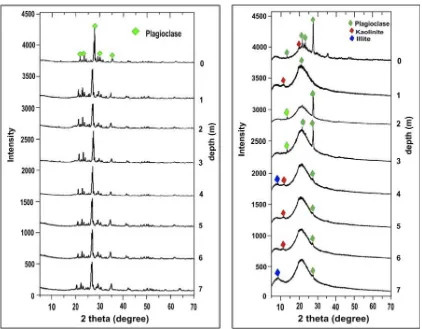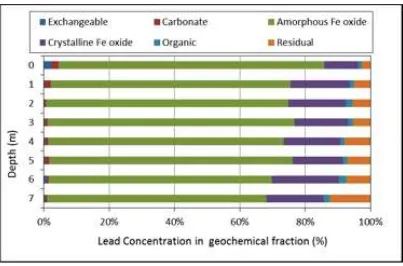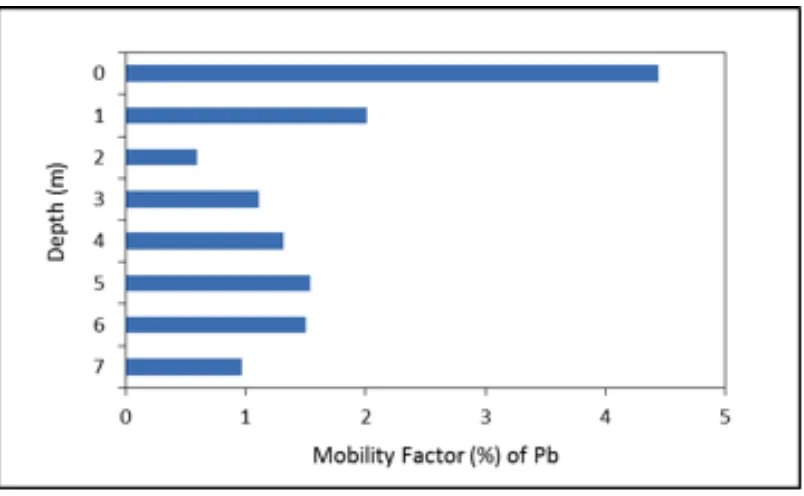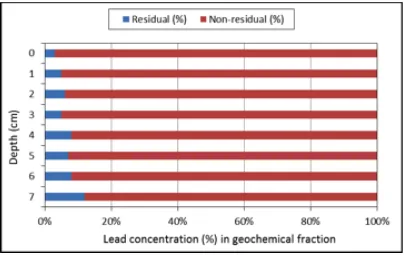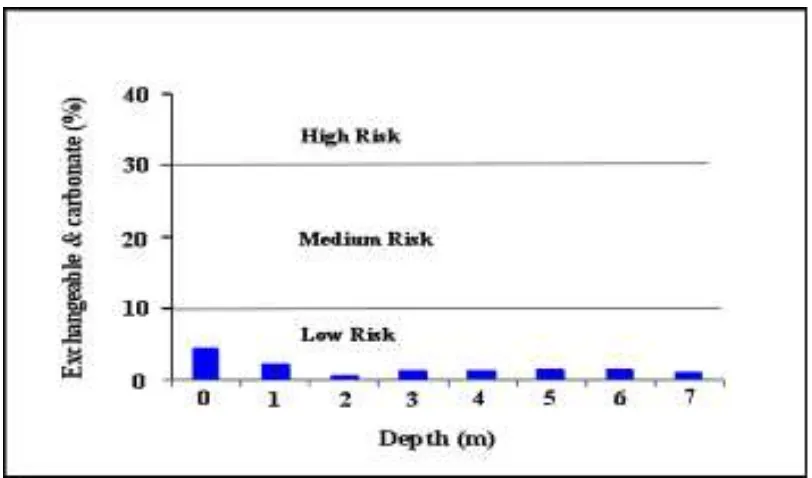GEOCHEMICAL FRACTION, MOBILITY AND
BIOAVAILABILITY OF LEAD IN UNSATURATED
SOIL OF YOGYAKARTA CITY, INDONESIA
Saw Aung Zaw Aye*1, Heru Hendrayana1, Doni Prakasa Eka Putra1, and Tsutomo Sato2
1Geological Engineering Department, Faculty of Engineering, Gadjah Mada University, Yogyakarta, Indonesia 2Laboratory of Environmental Geology, Faculty of Engineering, Hokkaido University, Kita 13 Nishi 8, Kita-Ku, Sapporo 060-8628, Japan
Abstract
Lead (Pb) is one of common heavy metals found in the soil of urban environment. In Yogyakarta City, Indonesia, lead content in the soil was already ported by some researchers, however all of the re-port were only reveals the distribution of lead con-centration in the soil. Therefore, this research pa-per aims to understand the geochemical fraction lead in the soil of Yogyakarta City and assess the mobil-ity and bioavailabilmobil-ity of lead release to the environ-ment. The soil sampling location is selected on Ko-tagede District, representing the oldest urban area of Yogyakarta city. A shallow bore hole was drill until about 7 m below the surface and soil/sediments were sampled for each 1 m depth started from the sur-face. Six steps of sequential extraction procedures were carried out to assess the geochemical fraction of Pb for each of soil samples. The sequential ex-traction shows that the highest amount of Pb in the soil of Yogyakarta City is found in amorphous iron oxide, crystalline iron oxide and non residual frac-tion form of Pb. Based on the results of geochemical fraction, the mobility factor of lead can be calculated and reveals low mobility factor range from 0.4 to 3.3 %. The mobility of lead is decreased from the sur-face to the deeper soil, on the other hand the bioavail-ability of Pb calculated from exchangeable and car-bonate fraction is also show low risk of bioavailabil-ity. Therefore, it can be concluded that although Pb
*Corresponding author: S.A.Z. AYE, Geological
En-gineering Department, Faculty of EnEn-gineering, Gadjah Mada University. Jl. Grafika 2 Yogyakarta 55281, Indone-sia. E-mail: sawthataw2@gmail.com
concentration is high in non-residual fraction, Pb is in low risk condition due to its poor mobility and bioavailability. But, concern on lead contamination should be considered because if the concentration of Pb is enriched over the adsorption capacity of iron oxide, it can easily release to the environment and can impact to human in the future.
Keywords: Yogyakarta city, Lead, Sequential ex-traction, Geochemical fraction
1 Introduction
automo-bile air emissions was a major exposure source (Alloway, 2013).
As for humans, poisoning with Pb is a major environmental and public hazard, especially for infants and young children. Pb enters the body mainly by skin contact and inhalation, and is metabolized in the liver. Typical symptoms of Pb poisoning include general fatigue, tremor, headache, vomiting, seizures, blue-black lead line on gingival tissue, and colic. Pb also inter-feres with hemoglobin synthesis, and severely damages kidney functions. It affects the via-bility of the fetus and its development (Bradl, 2005). In order to estimate effects and potential risks associated with elevated heavy metal con-centrations that result from anthropogenic ac-tivities, the fraction of total metals that is bio-available must be identified. Sequential extrac-tion provides informaextrac-tion on the partiextrac-tioning of metals which can be useful in the understand-ing of mobility and bioavailability (Kumaret al., 2011).
Yogyakarta City is located in the central part of Java Island. In the 1930’s, Yogyakarta was just a small town in the interior of Java with a population of approximately 60.000 inhabitants (Baiquni, 1994). In the last two decades, urban-ization has transformed the structures of Yo-gyakarta City and it grows beyond its adminis-trative boundary with about one million inhab-itants. Until now, settlement pattern was shift-ing to many direction defined by main road net-works and service centers and growing hand in hand with new business centres, education and tourism centres without proper infrastruc-tures (Putra, 2007). Yogyakarta city is the capi-tal of Yogyakarta Special Province, situated in Central Java, Indonesia. The city is located only about 30 km from the Merapi Volcano, and about 40 km from the coast of the Indian Ocean. The peak of the volcano reaches the el-evation of 2911 m above sea level (Karnawati
et al., 2006). Kotagede district, the south east-ern part of Yogyakarta city, approximately cov-ers 27 ha and is located about 141 m above the mean sea level. Most of the area is widely cov-ered by settlement. The area was established as the Capital of Mataram Sultanate in 16th cen-tury and it was the oldest place, and renowned
with silver artwork in Yogyakarta city. Since the establishment of Kotagede as the capital of Mataram, the traditional silver, gold, cop-per industries began to develop. The conse-quences of urban growth can be occurred the impacts of human activities. There are many home industries like silver, leather and batik in Yogyakarta city, especially in the Kota Gede dis-trict (Wilopo et al., 2010). The numbers of ve-hicles and the roads on this city is increased during the 2000 up to now. As a result, lead concentration in top soil increased by anthro-pogenic activity with regard to the degree of traffic density in urban area of Yogyakarta City (Budianta, 2001). Therefore, the study was con-ducted to determine the geochemical fraction, mobility and also the bioavailability of Pb in soil/sediment of Yogyakarta City.
2 Materials and Methods
2.1 Sample collection
Soil samples for Pb analysis were collected by using hand auger drilling from surface to a 7 m depth and packed in zip lock plastic bags.
2.2 Sample preparation
The collected soil samples were air dried at a room temperature. The stones, gravel and coarse plant roots or residues were removed to obtain a homogenous sample. After that, the soil samples were crushed and sieved through a 1 mm opening mesh and stored in plastic bags prior to chemical analysis. The mineralogical composition of the soil samples was analyzed using an X-ray diffractometer (XRD), while the chemical composition was determined using an X-ray fluorescence spectrometer.
2.3 Sequential extraction experiments
were used for sequential extraction in the labo-ratory. Six steps of sequential extraction proce-dures conducted in this study were as follows:
1. Exchangeable fraction (F1); 0.2 gram of soil
was mixed with 1 M MgCl2(1.6 mL)
shak-ing for 2 hr at room temperature in 150 rpm. After extraction, the filtrate was col-lected and diluted to 8 mL for analysis. 2. Carbonate fraction (F2); the residual from
(F1) was mixed with 1 M sodium acetate
(NaOAc) (1.6 mL), adjusted to pH 5.0 with the reagent-grade acetic acid (HOAc) and shaken for 24 hr at room temperature. The filtrate was collected after extraction and diluted to 4.8ml for analysis.
3. Amorphous iron oxide fraction (F3); the
residue from (F2) was mixed with 0.1M
NH2OH. HCl and 0.1M HNO3 (8 mL) by
shaking in 30 min at room temperature. The filtrate was diluted to 6 ml for analy-sis.
4. Crystalline iron oxide fraction (F4); the
residue from (F3) was mixed with 0.2M
Amonium oxalete (8 mL) by shaking 3 hr at room temperature. The filtrate was di-luted to 6 ml for analysis.
5. Organic fraction (F5); the residue from (F4)
is mixed with 0.7 M NaOCl (12.5 ml), and shakes 40 min at 115 ºC. After shaking, the mixture was left for 30 min to cool. The fil-trate was diluted to 50 ml prior to analysis. 6. Residual fraction (F6); the residue from (F5)
is mixed with 1M HCl (6.6 ml), and shakes 2 hours at room temperature. After shak-ing, the filtrate was diluted to 50 ml ready for analysis.
3 Results and Discussion
3.1 Mineralogy and chemical composition of soil
Results of XRD analysis of the soil samples showed that plagioclase was mainly present in the bulk soil sample, while kaolinite, plagio-clase and illite were present in clay-size frac-tions of the soil samples (Figure 1). Chemical compositions of the soil samples as shown in
Table 1 are SiO2, Al2O3, Fe2O3 with
percent-ages of 58.50 to 51.1 wt.% (average 56.64 wt.%), 21.20 to 17.00 wt.% (average 19.64 wt.%) and 9.66 to 6.39 wt.% (average 7.75 wt.%), respec-tively as high content of major elements in the soil. The other major elements such as TiO2,
P2O5 and MnO are ranging from (1.01 to 0.68
wt.%), (0.49 to 0.36 wt.%) and (0.26 to 0.18 wt.%) with the average weight percent of (0.79 wt.%), (0.44 wt.%) and (0.22 wt.%) are can be seen as small amount of concentration. High concen-tration of SiO2 and Al2O3 are contributed by
clay minerals such as illite. The clay minerals originated from the hydrolysis of plagioclase in the volcanic rocks.
3.2 Geochemical fraction of lead
The geochemical fraction of lead (Pb) in ex-changeable fraction is ranging from 0.18 to 2.83 ppm with an average concentration of 0.61 ppm (0.59%), in carbonate fraction is ranging from 0.43 to 2.91 ppm with an average value of 1.08 ppm (1.10%), in amorphous Fe Oxide fraction is ranging from 41.09 to 105.25 ppm with the aver-age of 68.99 ppm (73.38%), in crystalline Fe Ox-ide fraction is ranging from 11.06 to 20.96 ppm with an average concentration of 14.99 ppm (16.65%), in organic fraction is ranging from 1.06 to 2.15 ppm with an average of 1.39 ppm (1.55%), and in residual fraction is ranging from 3.51 to 7.86 ppm with an average of 5.72 ppm (6.73%). The value of lead concentration in chemical fraction and their percentages of geo-chemical fraction are shown in Figures 2 and 3. Results of sequential extraction showed that Pb were concentrated mainly in amorphous Fe oxide in the soil profile with average of 73.38 %. It was followed by crystalline iron oxide with the average of 16.65 %. Metals associated with oxide (both amorphous and crystalline) miner-als were likely to be released in reducing con-dition (Sharmin et al., 2010). The exchangeable fraction can be seen as negligible amount with average of 0.42 % and small amount of carbon-ate fraction 1.04 % are occurred in the unsatu-rated soil.
Musta et al., 2008, mention that the concen-tration of Fe2O3 in soil samples indicates the
Figure 1: XRD pattern of unsaturated soil in (a) bulk sample, (b) clay fraction
Table 1: Chemical composition of soil samples.
Chemical composition (wt.%) Minimum Maximum Average
SiO2 51.1 58.5 56.64
Al2O3 17 21.2 19.64
Fe2O3 6.39 9.66 7.75
CaO 4.69 10.6 6.18
Na2O 2.34 3.22 2.63
K2O 1.45 2.13 1.66
MgO 0.92 1.63 1.22
TiO2 0.68 1.01 0.79
P2O5 0.36 0.49 0.44
Figure 2: Geochemical fraction of Pb in soil samples.
soil. The result of sequential extraction on this research agree with this statement as Pb content that bound to amorphous Fe oxide fraction are showing positive correlation with the percent of iron oxide in the soil/sediment sample (Figure 4).
3.3 Mobility of lead
The determination of mobility of metals (Pb) in unsaturated soil may also be assessed on the ba-sis of absolute and relative content of fractions weakly bound to soil components. The relative index of metal of metal mobility was calculated as mobility factor (MF) on the basis of the fol-lowing equation (Kabala and Singh, 2001):
MF= (F1+F2)
(F1+F2+F3+F4+F5+F6 ×100 (1)
Where:
F1=Exchangable fraction
F2=Carbonate fraction
F3=Amorphous Fe Oxide fraction
F4=Crystalline Fe Oxide fraction
F5=Organic fraction
F6=Residual fraction
The above index describes the potential mo-bility and it is the ratio of proportion of mobile (F1 + F2) to the total sum of all fractions. The
MF gave the value in the range from 0.4 to 3.3 % for Pb. The mobility of Pb in unsaturated soil of the study area indicates that they are likely have higher mobility on the surface soil and describes more available for plant and ani-mal than the deeper part in the study environ-ment. The relatively higher mobility of Pb on the surface soil seemed to be related to the pol-lution due to atmospheric deposition especially from traffic emission of vehicle in urban envi-ronment (Figure 5). Mobility of Pb at deeper soil/sediment show relatively lower mobility than soil in the surface area. The lower mobil-ity of lead in deeper soil/sediment means that the probability of lead release to groundwater is also low.
3.4 Bioavailability of lead
Metals in non-residual fraction that include from exchange to crystalline Fe oxide which are
likely to be bioavailability than metals associ-ated with residual fraction (Oluwatosin et al., 2008). In the present study, the percentage of the non-residual forms of heavy metal are sum of the first five fractions (F1, F2, F3, F4 and F5)
and non-available form of the heavy metal was consider as residual fraction (F6), see Figure 6.
Figure 6 shows that most of fractions of all the investigated heavy metals (Pb) were found in non-residual (available) form with 88 to 97% with mean value of 94% and residual (available) form from 3 to 12% with the mean of 7%.
A significant percentage of Pb was associated with non-residual fractions could be considered as potential available fractions means that Pb is readily available for plant uptakes and bio-accumulation and could be environmental risks (Jimohet al., 2013). Furthermore, Hongleiet al.
(2008) mentioned that the present of more than 50% of Pb associated with non-residual fraction of unsaturated soil has indicated the influence of anthropogenic activities and Pb has the po-tential bioavailability.
The dissolution and consequently the mobil-ity and bioavailabilmobil-ity of metals are controlled by organic matter and oxides that act as prin-cipal adsorbents and this can prevent excessive mobilization of heavy metals (Oluwatosinet al., 2008). Beside, due to less concentration of Pb in exchangeable and carbonate fraction, Pb is not readily available for biological uptake and eas-ily released to the environment and Pb that is adsorbed by amorphous Fe oxide in soil com-monly have poor mobility and bioavailability (Violanteet al., 2010).
amor-Figure 4: Correlation of Fe2O3 (%) and Pb in amorphous iron oxide fraction.
Figure 6: Non-residual and Residual concentration of Pb in soil samples.
phous and crystalline) minerals can be released to the environment (Sharminet al., 2010).
In order to quantify the bio-availability of Pb in the study area, an assessment of risk to determine the availability of Pb in soil is con-ducted. This assessment called as Risk Assess-ment Code by applying a scale to the percent-age of heavy metals in the exchangeable and carbonate fractions (Al-Robai, 2013). Exchange-able and carbonate bound metals are weakly bound to sediment components and may be considered more mobile and dangerous than other fraction. The risk assessment code in-dicates the sediment which can release heavy metal in exchangeable and carbonate fractions of the total concentration <1 (No risk) will be
considered safe for the environment, 1–10 (Low risk), 11–30 (Medium risk), 31–50 (high risk),
>50 (very high risk), and can easily enter the
food chain (Sharmin et al., 2010). Using this RAC method, the Pb in unsaturated zone in the study area is classify into low risk zone (Fig-ure 7). Therefore, it can be concluded that Pb contamination in soil of the study area is poorly bio-available. Even there is a low risk level of Pb in the unsaturated soil in the study area, it
should be considered due to its negative impact for the human health in the future.
4 Conclusion
con-Figure 7: Risk Assessment Code of Pb in unsaturated soil.
centration of Pb is enriched over the adsorption capacity of iron oxide, it can easily release to the environment and can impact to human in the future.
Acknowledgement
Authors would like to thank the ASEAN University Network Southeast Asian
Engi-neering Education Development Network
(AUN/SEED-Net) program under the Japanese International Cooperation Agency contribution (JICA) and Center for Engineering Education Development (CEED), Hokkaido University for financial support academic contribution to this research.
References
Alloway, B.J. (2013) Heavy Metals in Soils: Trace Metals and Metalloids in soils and their Bioavailability, 3Ed, Springer, UK.
Al-Robai, H.A.H. (2013) Determination some heavy metals in sediments of Shatt Al-Hillriver by using modified single chemical fractionation technique, Journal of Babylon University, Pure and Applied Sciences, Vol. 21, No. 8, pp. 42-50.
Baiquni, M. (1994) Household Income and Decentralized Urban Infrastructure A Case Study of the Integrated Urban Infrastructure Development Programme -Yogyakarta Ur-ban Development Project. Thesis (Master), Institute of Social Studies, Netherlands. Budianta, W. (2012) Lead contamination in
soil of Yogyakarta city, Indonesia, J. SE AsianAppl. Geol., Vol. 4, No. 2, pp. 90-98.
Bradl, B.H. (2005) Heavy Metals in the Environ-ment, Elsevier Ltd, ISBN: 0-12, 088381-3. Herath, H. M. D. V., Pitawala, H.M.T.G.A.,
Gunathilake, J. and Dalugoda, T.Y.S. (2013) Heavy metal contamination in road de-posited sediments in Colombo urban area. Proceedings to 29thTechnical Sessions of Ge-ological Society of Sri Lanka, pp. 127-130. Honglei, L., Liqing, L., Chengqing, Y., and
Baoquing, S. (2008) Fraction distribution and riskassessment of heavy metals in sediments of Moshi lake, Journal of Environmental Sci-ences, Vol. 20, pp. 390-397.
Kabala, C. and Singh, B.R. (2001) Fractionation and mobility of copper, lead, and zinc insoil profiles in the vicinity of a copper smelter, J. Environ. Qual. No. 30, pp. 485-492.
Kanmani, S. and Gandhimathi, R. (2012) As-sessment of Heavy metal contamination in soildue to leachate migration from an open dumping site, Applied Water Science, No. 3:193–205.
Karnawati, D., Pramumijoyo, S. and Hen-drayana, H. (2006) Geology of Yogyakarta, Java: thedynamic volcanic arc city, The Ge-ological Society of London, IAEG, No. 363, pp. 1-7.
Kumar, B., Kumar, S., Mishra, M., Singh, S.K., Prakash, D., Sharma, C. S. and Mukher-jee, D.P. (2011) Geochemical fractionation of some heavy metals in soils in the vicinity of sukinda mining area, Orissa”, Advances in Applied Science Research, Vol. 2, No. 5, pp. 263-272.
Manta, S. D., Angelone, M., Bellanca, A., Neri, R. and Sprovieria, M. (2002) Heavy metals in-urban soils: A case study from the city of Palermo (Sicily), Italy, Sci.Env. Elsevier Sci-ence, No. 300, pp. 229-243.
Moore, F., Forghani, G. and Qishlaqi, A. (2009) Assessment of heavy metal contamination in-water and surface sediments of the Maharlu Saline lake, SW Iran, Journal of Science & Technology, Transaction A, Vol. 33, No.1, pp. 43-55.
Musta, B., Fitria, H.W.S.E. and Tahir, S. (2008) Geochemical characterization of volcanic soils form Tawau, Sabah, Bulletin of the
Ge-ological Society of Malaysia, Vol. 54, pp. 33-36.
Oluwatosin, G.A., Adeyolanu, O.D., Dauda, T.O. and Akinbola, G.E. (2008) Levels and-geochemical fractions of Cd, Pb and Zn in valley bottom soils of some urban cities in southwestern Nigeria, African Journal of Biotechnology, Vol. 7, No. 19, pp. 3455-3465. Putra, D.P.E. (2007) The Impact of
Urbaniza-tion of Groundwater Quality – A Case Study in Yogyakarta City – Indonesia, Mitteilun-gen zur InMitteilun-geniuergeologie und Hydrogeolo-gie, Heft 96, 148 S, Herausgegeben Vom (Lehrstuhl) fuer Ingenieurgeologie und Hy-drogeologie, University Prof. Dr. Azzam, RWTH, Aachen, Germany.
Sharmin, S.H.M., Zakir, H.M. and Shikazono, N. (2010) Fractionation profile andmobility pattern of trace metals in sediments of Nomi River, Tokyo, Japan, Journal of Soil Science and Environmental Management Vol. 1, No. 1, pp. 001-014.
Tessier, A., Campbell, P.G.C. and Bisson, M. (1979) Sequential extraction procedure forthe speciation of particulate trace metals, Analyt-ical Chemistry, Vol. 5, pp. 844-851.
Violante, A., Cozzolino, V., Perelomov, L., Ca-porale, A.G. and Pigna, M. (2010) Mobil-ityand bioavailability of heavy metals and metalloids in soil environments, J. Soil. Sci. Plant Nutr. Vol. 10, No. 3, pp. 268-292. Wilopo, W., Haryono, S. N., Putra, D. P. E.,
